AMD Socket-AM2: Same Performance, Faster Memory, Lower Power
by Anand Lal Shimpi on May 23, 2006 12:14 PM EST- Posted in
- CPUs
A New FX
The next new CPU introduction that we're here to evaluate is the Athlon 64 FX-62, a 2.8GHz dual-core FX part that's debuting exclusively on the Socket-AM2 platform. Given AMD's policy of only having one active FX part at a time (prior violations of this rule aside), the FX-62 is the only FX on the AM2 platform. The FX-60 still reigns supreme on the Socket-939 platform, and since the two platforms perform the same we can pretty much compare the FX-60 to the FX-62 directly without worrying about any motherboard/memory/chipset differences skewing the comparison. Of course no very-high-end CPU comparison is complete without Intel's latest Extreme Edition processor, which in this case is the Pentium Extreme Edition 965 we reviewed back in March.
3D Rendering - Cinebench 9.5
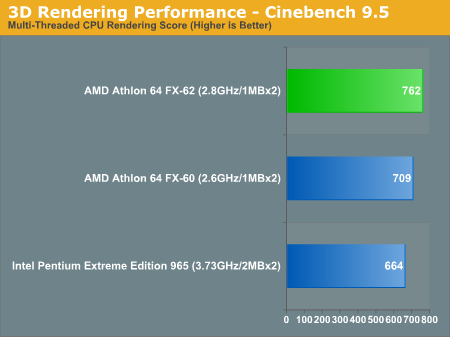
The beauty of the FX series of AMD processors is that its cache size doesn't vary like the rest of the Athlon 64 line, so the FX-62 has an undeniable performance advantage thanks to its 2.8GHz clock speed. The clock speed advantage is able to give it a pretty decent performance boost over the FX-60 here, as well as over the Pentium EE 965.
3D Rendering - 3dsmax 7
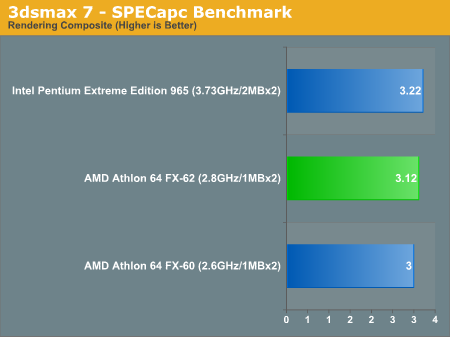
While we see a performance increase over the FX-60 in 3dsmax 7, it isn't enough to catch up to the performance of the Pentium EE 965. At 3.73GHz, the 965 is an extremely formidable competitor and very high performance CPU for 3dsmax rendering tasks.
Video Encoding - DivX 6.1.1 Pro

Intel gets the slight nod in DivX encoding performance, with the FX-62 falling smack in the middle of the chart here between the 965 and the FX-60.
Video Encoding - Windows Media Encoder 9
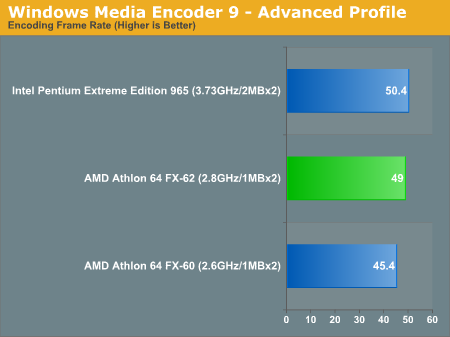
The situation doesn't really change with WME9; the FX-62 manages to come very close to the Extreme Edition 965's performance but falls a little short. The improvement over the FX-60 is quite noticeable here.
Video Encoding - Quicktime 7.0.4 (H.264)
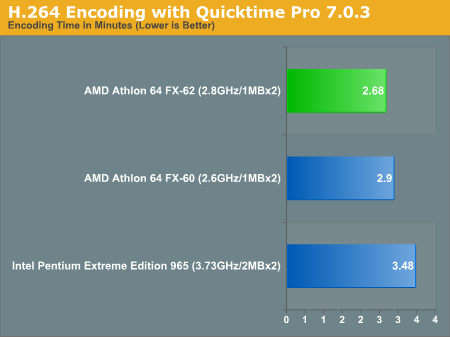
Apple's Quicktime for Windows has never run well on Intel processors, and the FX-62 takes good advantage of that fact by putting the Extreme Edition 965 to shame in our H.264 encoding test. After looking at the 4000+ vs. 3800+ comparison on the previous page, it's nice to see a real tangible performance difference between two AMD CPUs.
MP3 Encoding - iTunes 6.0.1.4
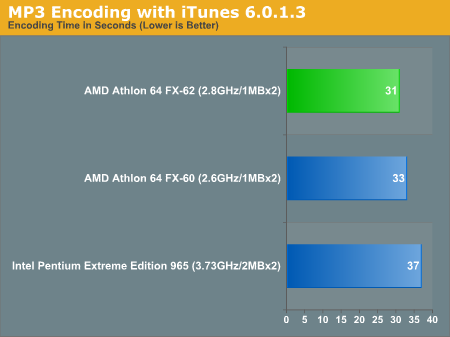
While all three CPUs are very competitive in their MP3 encoding performance the Athlon 64 FX-62 is the clear winner here, finishing the encoding task 16% faster than the Pentium EE 965.
Gaming - Quake 4
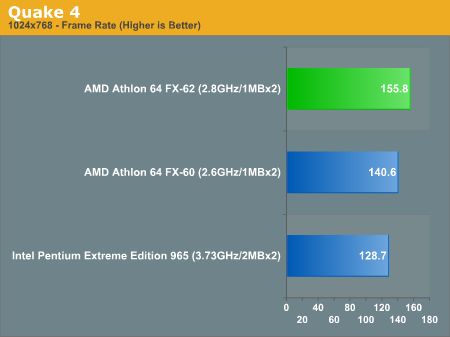
At higher clock speeds the Athlon 64 FX-62 really separates itself from the Pentium EE 965, offering a very significant 21% performance advantage in Quake 4.
Gaming - F.E.A.R.
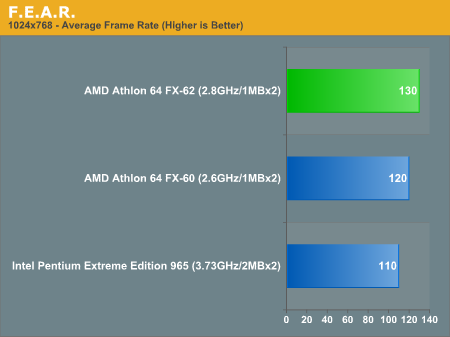
The AMD gaming advantage continues in F.E.A.R., this time the FX-62 holds on to a solid 18% lead.
Gaming - Oblivion
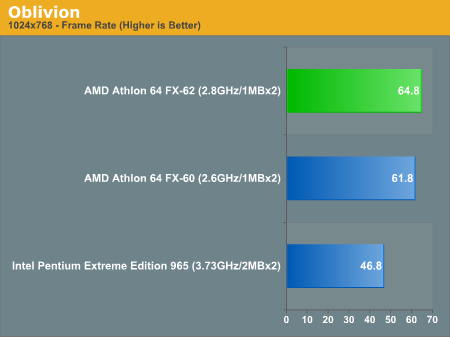
The Pentium Extreme Edition 965 is utterly disappointing in Oblivion, as the FX-62 outperforms it by an incredible 38%. With a very CPU and GPU dependent game like Oblivion, you can't ignore these types of performance differences, especially if you plan on feeding a pair of high end GPUs in SLI or CrossFire.
Athlon 64 FX-62 Conclusion
The Athlon 64 FX-62 verdict is a lot easier than with the 4000+ since the performance advantage is clear thanks to a 1MB L2 cache per core and an increase in clock speed. We would still recommend the FX-62 over the Extreme Edition 965 for gamers, but as we've seen in the past there are some situations where being able to execute four simultaneous threads, as you can with the EE, has its benefits.
Given the incredible price premium you pay for the FX-62, we would still strongly recommend going with a lower clocked Athlon 64 X2 instead. You can always overclock to get close to FX-62 performance or, alternatively, you could stay at the lower clock speed and enjoy lower thermal output.










83 Comments
View All Comments
darkdemyze - Tuesday, May 23, 2006 - link
z-ram isn't due for AMD procs for quite some time, I doubt this is their plan for June..mlittl3 - Tuesday, May 23, 2006 - link
Basically this is what I said above for my guess of the "trick" AMD will use. Anand said it will only affect some high-end users, read FX series so it can't be price cuts as some have suggested (that would effect everyone). Adding L3 cache is the only performance improvement I can think of that doesn't require changing the microarchitecture of the cores (well at least not a big change).However, TDP is still an issue here as someone above suggested. I don't know how much more power it takes to run L3 cache. Last time AMD did it was on K6 and power wasn't really measured back then.
By the way, please ignore Questar's comment below about z-ram being pig slow. I really don't think he knows what he is talking about. /shields eyes from incoming Questar flame
johnsonx - Wednesday, May 24, 2006 - link
K6-III did not have L3 cache. It had L2 cache, making the cache that all socket-7 boards had then an L3 cache.So, let's stop saying things like 'AMD hasn't done L3 cache since K6-III', etc.
mino - Wednesday, May 24, 2006 - link
Well, IMHO the point is AMD has used exclusive 3-level cache structure in the past so they have som experience with thi arrangement.Questar - Tuesday, May 23, 2006 - link
No flame here, look it up for yourself.Z-RAM has high capacitive loading, which results in slow speed.
At 4MB it'll run half the speed of SRAM.
Questar - Tuesday, May 23, 2006 - link
Large amounts of Z-RAM are pig slow.Ecmaster76 - Tuesday, May 23, 2006 - link
Seriously, the one area an Athlon X2 would be bandwidth starved and does it get tested in the preview? NOIn the review? NO
How long ago did we know that the K8 was not bandwidth limited in single application usage? YEARS
So yeah, DDR2 din't increase the 3dMark, big surprise
mlittl3 - Tuesday, May 23, 2006 - link
I think 3dMark06 is multithreaded now so all available cores and bandwidth should be used within the limits of the program. I could be wrong about this however.Ecmaster76 - Tuesday, May 23, 2006 - link
3Dmark06 is almost completely GPU limited. The 3Dmark CPU score did increase a bit, but I really was referring to graphics benchmarks in general.cscpianoman - Tuesday, May 23, 2006 - link
I was just noticing the performance differences between the FX and the EE. In some cases the FX tromps the EE by "gasp" 30%! In other cases the EE makes it's mark. This is part of the reason I am skeptic on Conroe. Yeah it's good. But I always take what Intel, or AMD for that matter, with a grain of salt. Just today we saw the 30% advantage translate down to about 15%. This seems just like any other generation change where 15% is to be expected. The current hype for the Conroe is a product of Intel's excellent marketing dept.